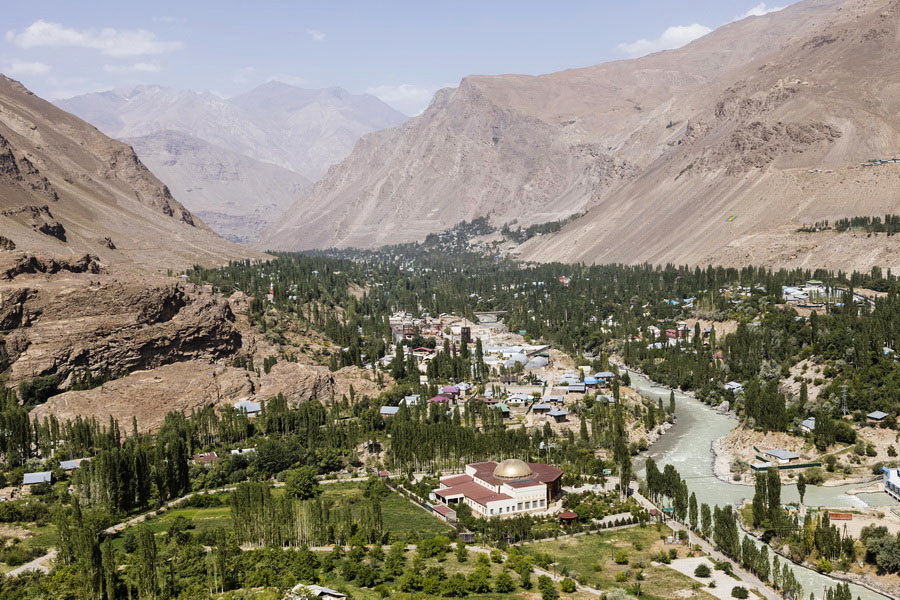Khorog, Tajikistan

Administrative center: Gorno-Badakhshan Autonomous Region
Elevation: 2,123 m
Official language: Tajik
Popular language: Russian, Uzbek etc.
Nationals: Uzbek, Tajik, Russian etc.
Time zone: UTC+5
Phone code: +992 35
Zip code: 736ХXX
Automobile codes: 04
Khorog is the only inhabited locality in the Gorno-Badakhshan Autonomous Region.
Khorog is also famous for the poems of the outstanding Soviet poet and bard Yuri Vizbor, who loved the mountains of Tajikistan.
Khorog-Osh highway, 1965
There are many roads in the worldBut you will not find higher - from the city of Khorog
Faraway to the city Osh
Up the rocky steeps, look, don't break off!
Climber-cars, climb upwards.
– Yuri Vizbor
Khorog is the capital city of the Gorno-Badakhshan Autonomous Oblast (GBAO) in Tajikistan. Its population is approximately 30,000, mostly of the Pamiri ethnic group. It is located at the bottom of a deep canyon (2,000 m) at the confluence of the Pyanj, Gunt, and Shakhdara rivers, right across the border from Afghanistan; the Pamir Highway runs through the middle of town. Nestled in a stunning scenic location, Khorog is the regional center for administration, trade, transportation, and especially, education.
The modest town boasts no less than four institutes of higher education. A number of Soviet-era plants for milk, meat, and bread production and several factories for the manufacture of such basic necessities as shoes and building materials still operate in Khorog. This is a very beautiful, green city, lined with huge poplar trees and quaint traditional Pamir houses in the outskirts. Though the town is relatively poor and suffered decline during the 1990's, in recent years, several new hotels and guesthouses have been founded, as well as internet cafes and restaurants featuring Tajik cuisine; the city is undergoing a major renewal and is peaceful and orderly.
International aid organizations are very active in the city's development, especially the Aga Khan Foundation and UN and EU development programs. Increasing numbers of travelers, though still relatively few, are bringing economic benefits and change.
Most major transportation routes in GBAO run through, or are reached, via Khorog, including the Pamir highway north to Dushanbe and west to the town of Murghab, China and Kyrgyzstan; a dirt road runs along the Wakhan valley to Alichur; and another rough route to the east along the Shakhdara Valley to peaks Karl Marx and Engels. Shared taxi services, utilizing Chinese 12-14 seat minibuses, operate from here to all points in the west, south to Ishkashem, and east to Alichur and Murghab. Trips to further destinations may require hiring a 4WD jeep or van (Russian UAZ), which is relatively more expensive. Arranging travel to Khorog from remote place such as Murghab can be more difficult. Khorog has a small airport, accessible by small propeller-driven aircraft, and regular flights leave for Dushanbe and other cities several times a week. It is the only regularly used airport in GBAO.
Several universities are located here, including a new branch of the University of Central Asia, Khorugh State University, and the Aga Khan Lyceum. The city's residents are known for their high level of education among Tajiks.
Architecture in the city is a typical Central Asian blend of traditional Pamir houses and Soviet-style buildings. Though the center of town (along the Pamir Highway) is entirely Soviet and rather ordinary, many unique and picturesque Tajik homes are built terrace-like along the river and into the hillsides above the town. A magnificent renovation of the main park along the Gunt River has recently been completed, where hundreds of people relax and spend time in summer. Though the climate is arid and surrounding canyons barren, the city is shaded by huge poplar and fruit trees and is very pleasant during the summer. A botanical garden with plants from all over the world is located on a hillside above the town.
Khorog was a complex of two small villages until the time of Russian expansion and the Great game. After the beginning of Soviet rule, it was made the capital of Gorno-Badakhshan in 1925, and has remained so ever since. Development was sustained during the Soviet period, and dozens of educational institutions, small factories, libraries, state farms were established. However, the economy and population declined during the early years of independence and the Tajik Civil War. During the war, it was a base for the independence movement of Gorno-Badakhshan, for which it suffered greatly; in recent years, it has made a good recovery, and, due to tourism and International aid (largely from theAga Khan foundation) promises to keep improving.
Weather: Khorog, being sheltered in a deep canyon at an altitude of 2,000m above sea level, is sheltered from high winds and cold temperatures in winter; summers are warm and dry.
